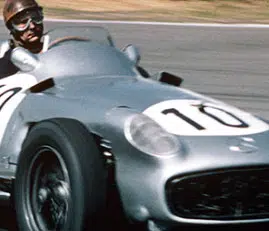The flat and rather uninteresting Paul Ricard circuit can be tackled from two opposing angles, or by a compromise. The layout is roughly rectangular with a long flat straight down one side, some “mickey-mouse” twists and turns at each end and a flat-out ess-bend in the middle of the other leg. You can either opt for maximum speed at the expense of cornering power, or sacrifice speed and concentrate on cornering, the choice being made by aerodynamic adjustments, the aerofoil settings for maximum down-thrust through the corners losing you maximum speed on the straight by reason of the increased drag. Some team engineers were in favour of concentrating on flat-out speed, but their drivers were more interested in cornering, while others were trying to achieve a balance between the two. Depending on the angles of the aerofoils the maximum speed on the long straight could vary between something like 175 m.p.h. and 190 m.p.h. and you could be on full song for as much as 30 seconds, Drivers generally being proud of their ability to go round corners showed little interest in speeding down the straight, though some were prepared to accept a compromise.
There were some new cars, new faces and new ideas about the paddock when it all began, the Tyrrell team turning out in a very strong force for the home Grand Prix of their major sponsor, the ELF petrol and oil company. Jody Scheckter had a brand new car, number six in the 007 series, some 50 lb. lighter by attention to the manufacture of detail parts and it had a wide base for the two alloy plates supporting the rear aerofoil, and in this space was built the oil system catch-tank for all the breathers. Depailler had his usual Tyrrell 007/4, while Scheckter’s usual car 007/2 was the team spare. In addition to the regular team there was Jean-Pierre Jabouille entered with 007/5, to boost up the French connection with the Tyrrell team. The Lotus team had done a number of modifications to their cars, Peterson’s spare car 72/R8 having “helper” coil springs added to the front suspension, to assist the torsion bars, these springs being wrapped round the telescopic shock-absorbers; it had also been altered drastically by having the wheelbase lengthened some five inches by out-rigging the engine away from the back bulkhead of the cockpit, on a tubular structure. In this space was mounted a new oil tank to replace the one over the gearbox, and in consequence the mounting for the rear aerofoil was new. The other Lotus, 72/R5, driven by Ickx, was also modified in this fashion, but without the coil springs.
The Ferrari team produced yet another of their 1975 cars, number 024 which was the fifth of the transverse gearbox models, and Regazzoni was using this while Lauda had 022. Both cars were still using the long thin tail-pipes on the exhaust system. In the Embassy-sponsored pits the Graham Hill mechanics were finishing off a new car for Brise, number GH1/4, while he was using the original Hill car, and in the Ensign pit the Dutch driver van Lennep was fitting himself into Morris Nunn’s brand new car, with inboard coil spring front suspension and inboard front brakes. The wandering French driver Francois Migault was in the Williams team for this race, Merzario having split with the team for good. With the weather very hot and the engines having to work hard down the long straight there were quite a few mechanical disasters and both of Frank Williams’ drivers broke their engines. Laffite on Friday and Migault on Saturday and a shortage of engines meant that the latter was unable to start in the race. Both the Parnelli team and the BRM team reversed their original plans before race day, Andretti preferring the training car 001 in place of 003, even though they were supposed to be identical and Bob Evans opting for the training BRM for the actual race, after P201/05 gave trouble on Saturday morning. Peterson tried both his Lotus cars and settled for the original short wheelbase car 72/R9, but with the coil spring units on the front, off the spare car, while Ickx had no choice. In the Brabham pits the spare car was fitted with glass-fibre mudguards to the front wheels, though their validity was in question.





